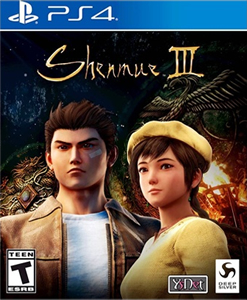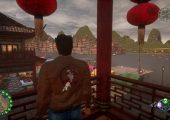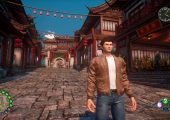Genre: Action/Adventure Developer: Ys Net Publisher: Deep Silver Players: 1 Released: 2019
The original Shenmue was a game I heard about some years after its release when the Dreamcast had been discontinued. The concept appealed to me, and when I got a Dreamcast a few years later, Shenmue was one of the first titles I sought out. By that time, much of its unique aspects had been copied or refined by other games. The sequel was out of my price range, but I was eventually able to play it over a decade after its release on the original Dreamcast. Even at the time, I could see that these two games didn’t have widespread appeal, but I thoroughly enjoyed both and fully appreciate how influential they were to so many games released since, including Sega’s Yakuza series.
 When the Kickstarter campaign for Shenmue III was announced in 2015, it wasn’t a hard decision to invest $60 in the promise of a sequel. It became the first of the very few crowdfunding campaigns I have contributed to. I did so assuming it would never make the planned 2017 release, so it wasn’t a surprise to see it finally arrive in November 2019.
When the Kickstarter campaign for Shenmue III was announced in 2015, it wasn’t a hard decision to invest $60 in the promise of a sequel. It became the first of the very few crowdfunding campaigns I have contributed to. I did so assuming it would never make the planned 2017 release, so it wasn’t a surprise to see it finally arrive in November 2019.
Before continuing with the review of the game, it is worth digressing to discuss some of the controversies surrounding its release. While I was not bothered by the delays, I was one of the many who was unhappy with some decisions made closer to launch. Most significantly when my physical edition became a DVD case with a download code and was moved from the Steam platform (where I had a registered account), to the Epic Games Store. Though not directly affected, I was also disappointed to see backers overlooked in other ways, including a separate retail collector’s edition that appeared much nicer than what backers were getting. With all this, I ended up being one of many to choose to have their investment refunded. None of this had anything to do with the quality or direction of the game’s development — I simply took the opportunity for a refund when the promises of my original investment were broken. Two years later, with all this behind me and largely forgotten, I picked up a copy of the game on PlayStation 4 for a fraction of the investment price and had an opportunity to focus on it without the politics surrounding the release.
As mentioned, the original games never had widespread appeal, and the HD re-releases of Shenmue I & II appeared earlier in 2019 before Shenmue III’s launched further highlighted their niche status. This isn’t an attack on the games, merely to make clear that Shenmue III was never likely to bring new interest to the franchise. It was, in reality, a unique opportunity to finish what was unfinished — not a blank cheque. Yu Suzuki, the series creator, did state early on that the story would continue beyond Shenmue III, but this was certainly wishful thinking.
In most ways Shenmue III retains the same design as the originals. There are a number of significant improvements, including a complete visual overhaul. The load times are also thankfully mostly gone, and you’re now able to skip towards specific times when required for story progression. The latter is optional, but even with both these improvements, the general pacing is close to the originals, which is no criticism. The soundtrack is probably my favourite aspect overall, with familiar compositions, as well as plenty of new ones. A truly amazing job was done with these, and the tracks that play during the daytime in the two hub areas of the game are particular stand-outs.
The biggest change to gameplay is the combat system, and this is definitely for the worse. The originals had similar mechanics to the Virtua Fighter series that hearken back to the original concept of the game as Virtua Fighter RPG. This system was great and though combat was relatively rare, it was always fun when it happened. In Shenmue III, it is more frequent but the combat is much slower, less responsive, and success relies far more on training Ryo’s abilities over player skill. The mini-games for training also happen to be the most tedious in the game, involving monotonous button pressing. These also have to be repeated over and over again for any progression. Each move you learn also has a slight delay between button inputs and action. Of all the changes to make to the original series, this seems the most out of place, especially since the Virtua Fighter series remains recognised and popular today.
Shenmue III continues immediately where Shenmue II ended, with Shenhua and Ryo finally arriving at her village. Shenhua’s stonemason father has disappeared, and thugs have been harassing other stonemasons in her home village of Guilin. Ryo is soon set free in the village to deal with the thugs, solve the mystery of Shenhua’s missing father, and generally waste time as the player sees fit. There is also the revenge story from the last games that comes in from time to time. From here, I get into spoiler territory, but it is enough to say that if you’re expecting a satisfying continuation in lieu of a satisfying ending, you’re going to be disappointed. There are two main areas of the game and both involve doing essentially the same thing. There is nothing that happens in Shenmue III that advances the story in any meaningful way, and I could say this even if I’d played the increasingly unlikely sequel.
There are things Shenmue III does very well, including the stunted and often hilarious voice work. The collectables, side-games, shops, and other distractions are still prominent ways to sidetrack the player. It is unfortunate that there are no classic arcade games, but this was always unlikely as Sega had limited involvement, and I’m sure Suzuki would have included some if he could. There are still fun activities to be found, and one area in particular gives a lot of genuine fan service to the many backers. The introduction of fishing was a particular highlight that absorbed a lot of game time for me. Ryo is also able to change his clothes now but changing his iconic outfit just seemed wrong, and I seldom took advantage of this feature.
Shenmue III then does some things very well and some things very poorly. The story and combat aspects are where the game really falters, and these were two areas that really needed to have been done right. I would easily rate both the originals higher than this even with the more streamlined aspects and much improved presentation. It is also hard to escape the feeling that this sequel could have been easily rearranged to bring the series to a satisfying, but abbreviated ending. With what was presented here, I have a hard time believing Suzuki really had the story all planned out with any detail. The controversies during its development have unfortunately sapped the overwhelming goodwill that saw the game funded, and as of writing there is not even a hint of a fourth installment. The incredibly cheap copy I was able to acquire also strongly suggests it didn’t sell very well. There is certainly fun to be found for series fans ,and I give a cautious recommendation to those who have yet to check it out. Shenmue III is by no means a disaster, but it is a wasted opportunity that I don’t expect to see repeated. Yet I still hope I will have to eat my words later.
SCORE (out of 5): 












Recent Comments